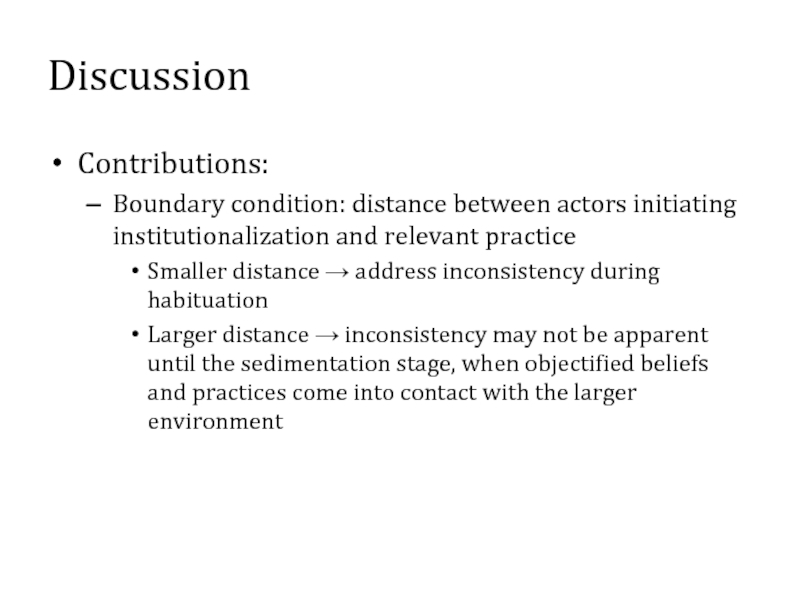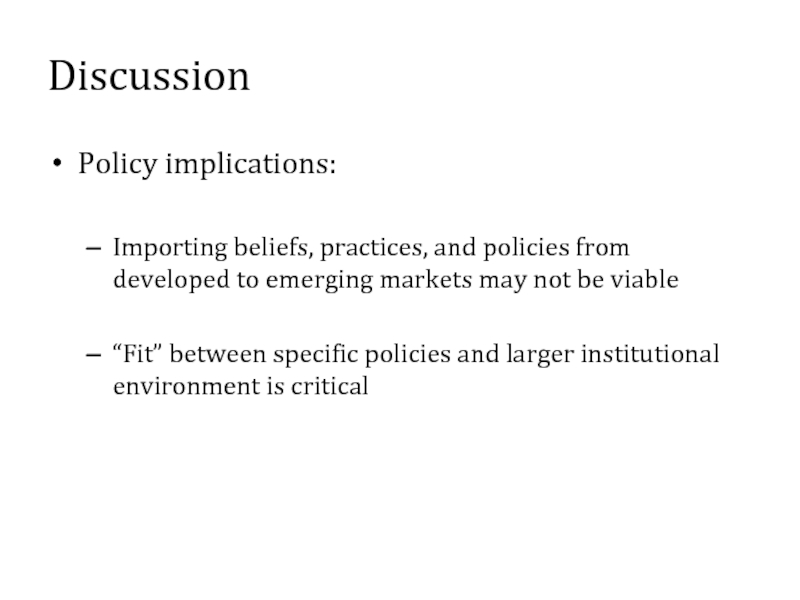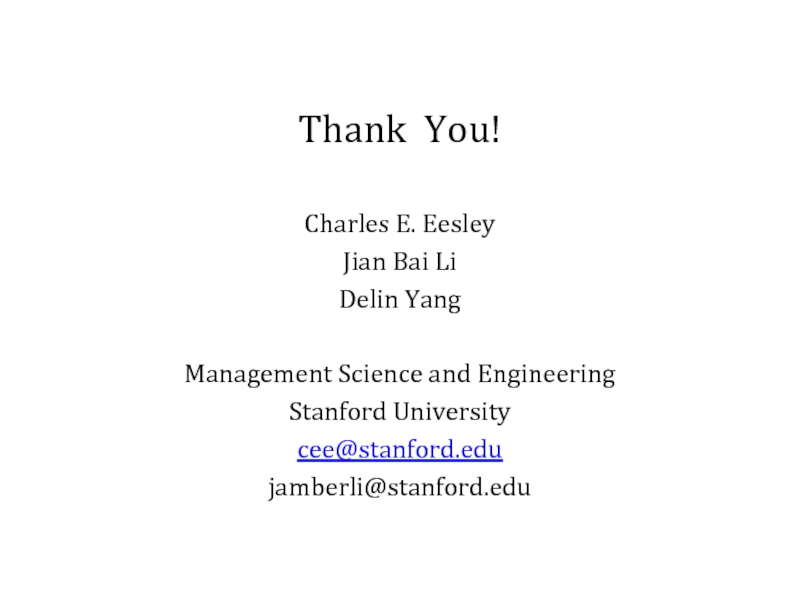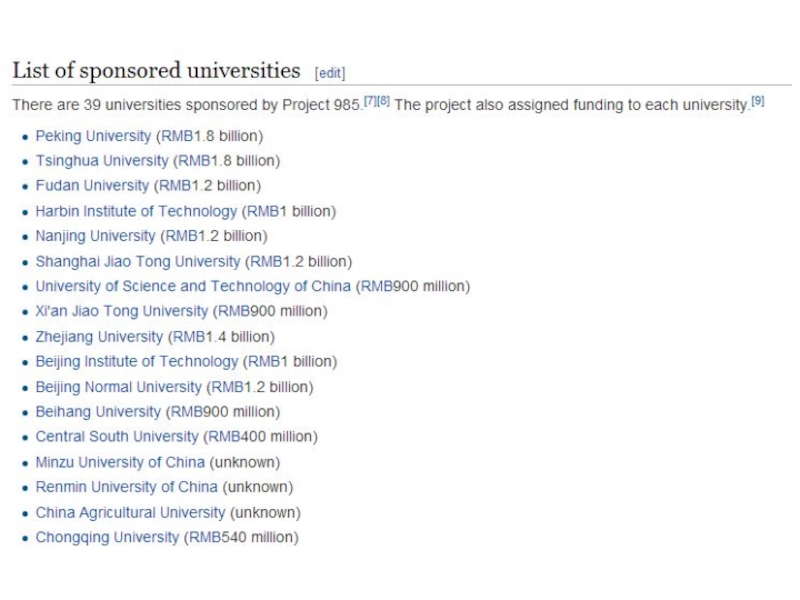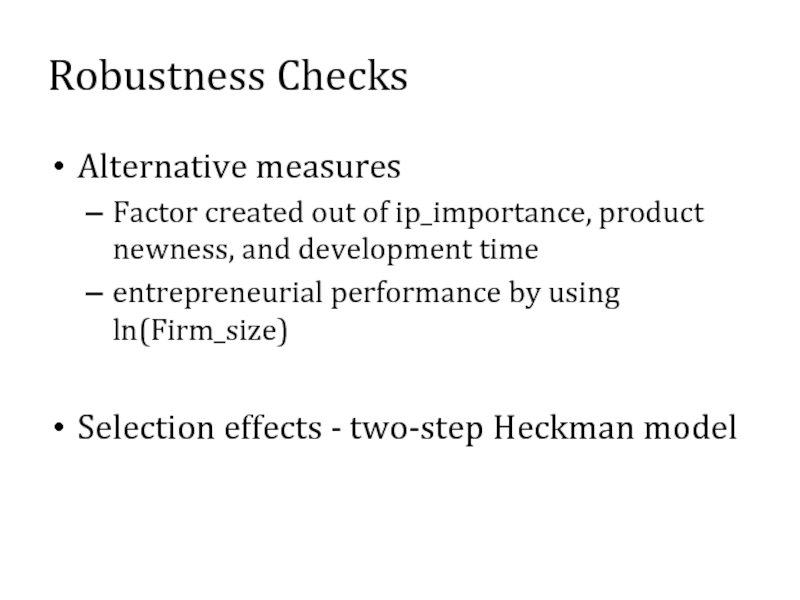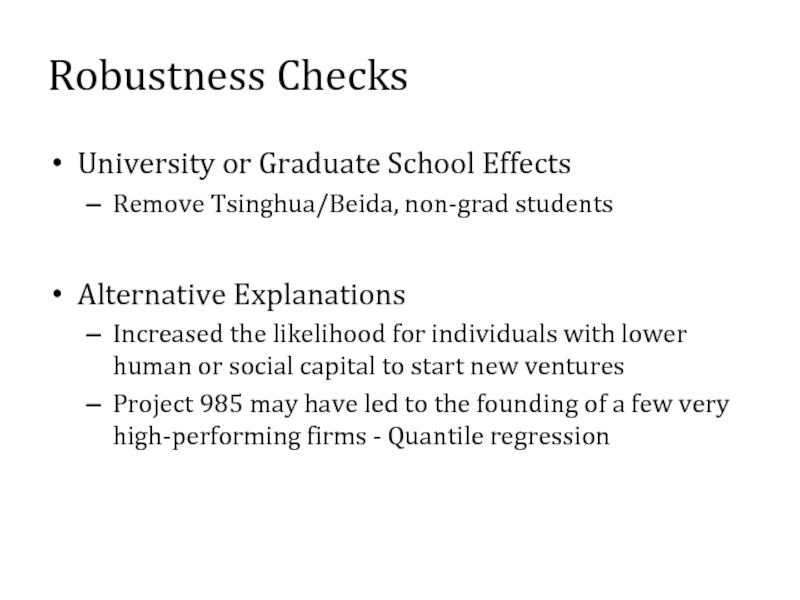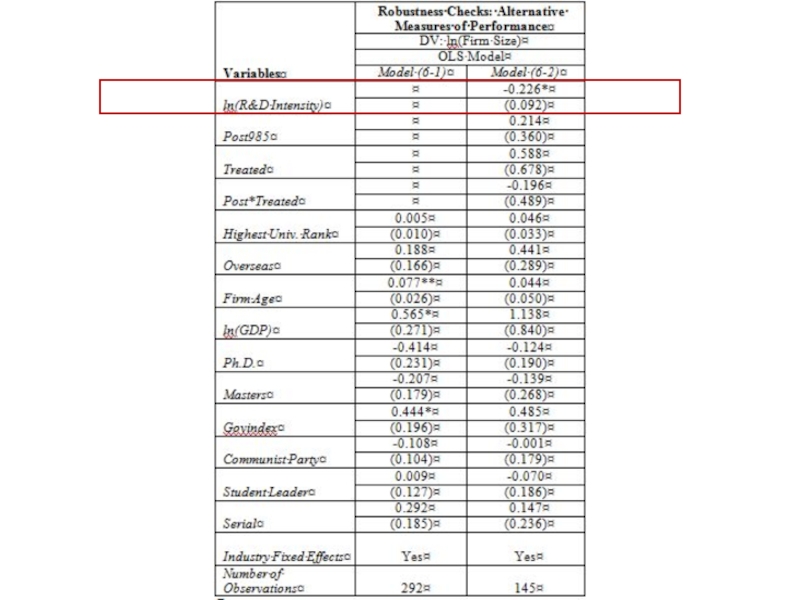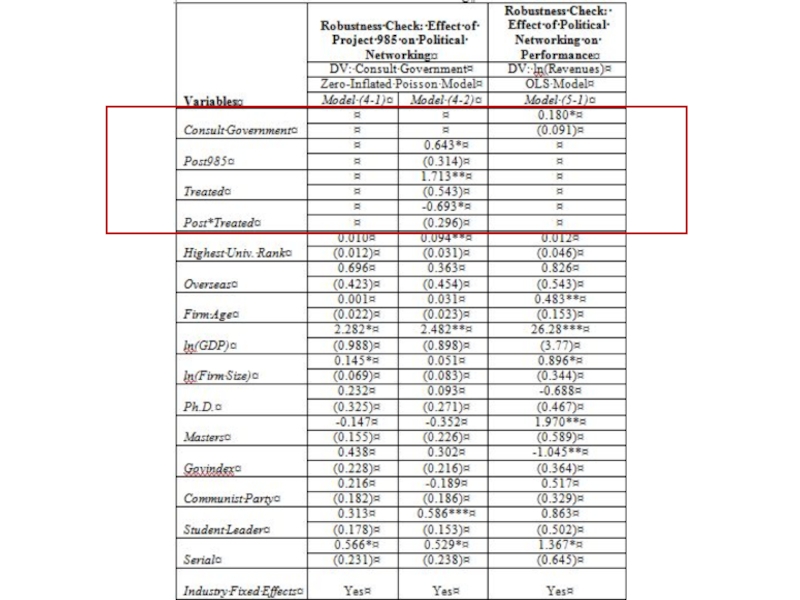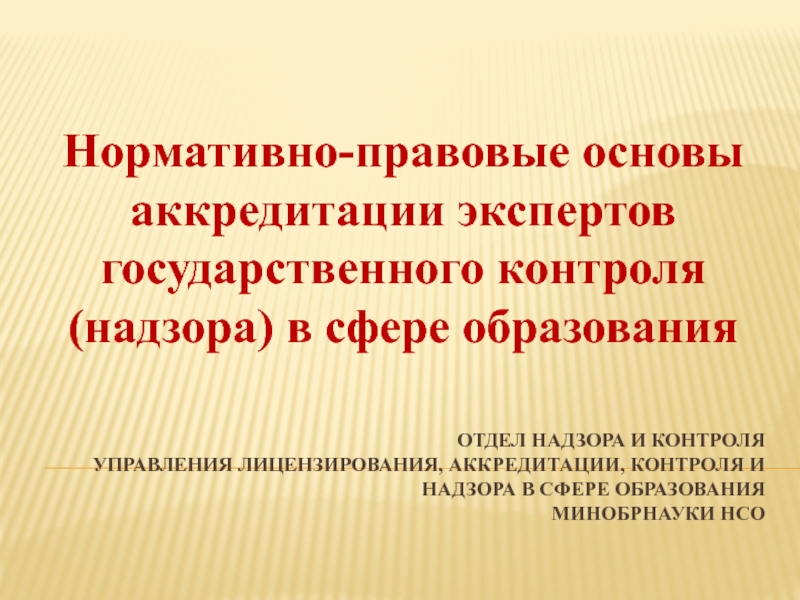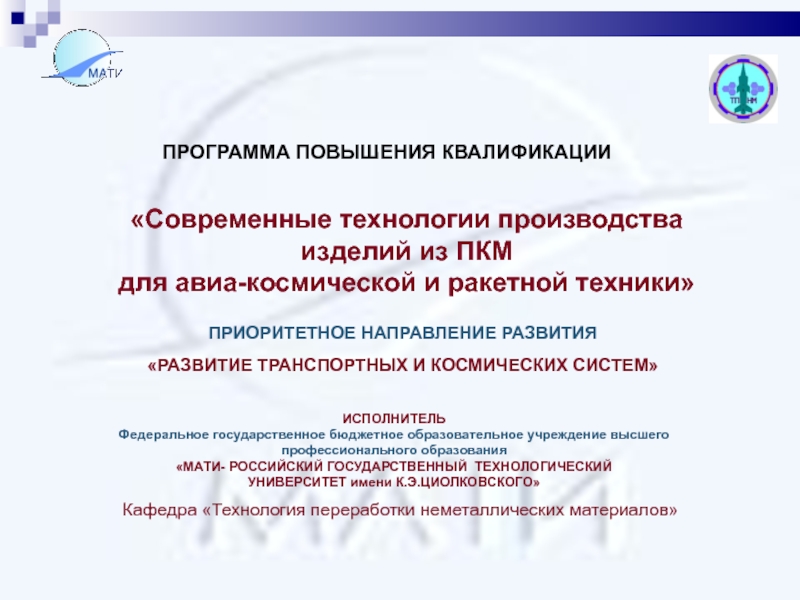Charles E. Eesley
Jian Bai Li
Delin Yang
- Главная
- Разное
- Дизайн
- Бизнес и предпринимательство
- Аналитика
- Образование
- Развлечения
- Красота и здоровье
- Финансы
- Государство
- Путешествия
- Спорт
- Недвижимость
- Армия
- Графика
- Культурология
- Еда и кулинария
- Лингвистика
- Английский язык
- Астрономия
- Алгебра
- Биология
- География
- Детские презентации
- Информатика
- История
- Литература
- Маркетинг
- Математика
- Медицина
- Менеджмент
- Музыка
- МХК
- Немецкий язык
- ОБЖ
- Обществознание
- Окружающий мир
- Педагогика
- Русский язык
- Технология
- Физика
- Философия
- Химия
- Шаблоны, картинки для презентаций
- Экология
- Экономика
- Юриспруденция
Does Institutional Change in Universities Influence High-Tech Entrepreneurship? Evidence from China’s Project 985 презентация
Содержание
- 1. Does Institutional Change in Universities Influence High-Tech Entrepreneurship? Evidence from China’s Project 985
- 2. Institutionalization Prior theory on institutionalization: 3 stages
- 3. Practitioner vs. Non-practitioner Practitioner initiates institutionalization: Habituated
- 4. Practitioner vs. Non-practitioner Non-practitioner initiates institutionalization Insufficient
- 5. Research Question How does institutional
- 6. Context: Project 985 Gov't policy: launched May
- 7. Hypotheses Project 985 fosters local environments that
- 8. Hypotheses Beliefs and strategic behavior Beliefs act
- 9. Hypotheses Innovation and IP is inconsistent with
- 11. Survey Construction Refined our measures through in-depth
- 12. Sample Population: 62.5% in engineering 11.9% in
- 13. Sample Tsinghua alumni survey: 723 entrepreneurs
- 14. Variables Dependent Variables H1: IP Importance, measure
- 15. Variables Independent Variables H1: Post*Treated, differences-in-differences estimator
- 16. Variables Controls Human Capital (Overseas, Masters, PhD,
- 17. Econometric Analysis H1: differences-in-differences analysis Treatment group:
- 18. Econometric Analysis H2: test direct effect of
- 25. Discussion RQ: how inconsistent institutionalization attempts actually
- 26. “Yes Project 985…had a pretty big effect
- 27. “I know that a lot of [Chinese]
- 28. Discussion Contributions: Boundary condition: distance between actors
- 29. Discussion Policy implications: Importing beliefs, practices,
- 30. Thank You! Charles E. Eesley Jian
- 32. Robustness Checks Alternative measures Factor created out
- 33. Robustness Checks University or Graduate School Effects
Слайд 1Does Institutional Change in Universities Influence High-Tech Entrepreneurship? Evidence from China’s
Project 985
Слайд 2Institutionalization
Prior theory on institutionalization: 3 stages (Berger and Luckmann, 1966; Tolbert
and Zucker, 1996; Scott, 2013)
Habituation: patterned behavior
Objectification: shared meanings
Sedimentation: exteriority
Implicit assumption: relevant practitioners initiate institutionalization process
Habituation: patterned behavior
Objectification: shared meanings
Sedimentation: exteriority
Implicit assumption: relevant practitioners initiate institutionalization process
Слайд 3Practitioner vs. Non-practitioner
Practitioner initiates institutionalization:
Habituated practices emerge out of repeated working
responses to real-life problems
Objectification a posteriori: meanings analytically abstracted from repeated practice
→Habituation serves as a filter: institutionalized ideas, structures, and practices must be viable within the larger institutional environment
Objectification a posteriori: meanings analytically abstracted from repeated practice
→Habituation serves as a filter: institutionalized ideas, structures, and practices must be viable within the larger institutional environment
Слайд 4Practitioner vs. Non-practitioner
Non-practitioner initiates institutionalization
Insufficient knowledge of challenges practitioners face and
insufficient incentive to find workable practices to tackle these challenges
Objectification a priori: meanings synthetically constructed or taken from another context
→Institutional inconsistency: institutionalized beliefs and practices don’t conform to the realities of the larger institutional context
Objectification a priori: meanings synthetically constructed or taken from another context
→Institutional inconsistency: institutionalized beliefs and practices don’t conform to the realities of the larger institutional context
Слайд 5Research Question
How does institutional change that attempts to institutionalize beliefs actually
affect the behavior and performance of their target organizations when such beliefs are inconsistent with the larger institutional environment?
Слайд 6Context: Project 985
Gov't policy: launched May 4th, 1998
Aim: increase the national
innovative and technological capability of China
Increase beliefs about the importance of intellectual property and innovation
Provided funding to universities for R&D (10-20% increase per year for 5 years)
At discretion of the univ
Equipment, labs, international conferences, attract overseas researchers, new curricula
Increased publication rates (Zhang et al., 2013)
Increase beliefs about the importance of intellectual property and innovation
Provided funding to universities for R&D (10-20% increase per year for 5 years)
At discretion of the univ
Equipment, labs, international conferences, attract overseas researchers, new curricula
Increased publication rates (Zhang et al., 2013)
Слайд 7Hypotheses
Project 985 fosters local environments that are conductive to the emergence
of positive beliefs regarding innovation and IP
Teachers and research mentors
Curriculum changes
Opportunities to practice innovation in lab settings
H1: Alumni who graduate from 985 universities after the implementation of Project 985 are more likely to hold the belief that intellectual property protection is important.
Teachers and research mentors
Curriculum changes
Opportunities to practice innovation in lab settings
H1: Alumni who graduate from 985 universities after the implementation of Project 985 are more likely to hold the belief that intellectual property protection is important.
Слайд 8Hypotheses
Beliefs and strategic behavior
Beliefs act as guides for how to interpret
info & make decisions (Rindova and Kotha, 2001; Tripsas, 2009)
Belief in innovation and IP → propensity to engage in innovation
H2: Firms founded by alumni who hold the belief that IP is important are likely to invest more in technologically intensive activities.
Belief in innovation and IP → propensity to engage in innovation
H2: Firms founded by alumni who hold the belief that IP is important are likely to invest more in technologically intensive activities.
Слайд 9Hypotheses
Innovation and IP is inconsistent with China’s institutional environment
Poor IP protection,
contract laws, and judiciary institutions (Xin and Pearce, 1996; Peng and Luo, 2000; Li and Zhang, 2007)
H3: Firms that invest more in technologically intensive activities are more likely to exhibit lower performance.
H3: Firms that invest more in technologically intensive activities are more likely to exhibit lower performance.
Слайд 11Survey Construction
Refined our measures through in-depth interviews with 42 entrepreneurs, investors,
and government officials.
Better understand the context of our study and improve the appropriateness and precision of our survey questions.
Follow-up phone calls with some of our respondents after the surveys were collected to gain better understanding of their answers.
Better understand the context of our study and improve the appropriateness and precision of our survey questions.
Follow-up phone calls with some of our respondents after the surveys were collected to gain better understanding of their answers.
Слайд 12Sample
Population:
62.5% in engineering 11.9% in sciences
12.9% in humanities (architecture, medicine and
law comprise the remainder)
25-30% women19.2% doctorate degrees
53.4% graduate degrees
25-30% women19.2% doctorate degrees
53.4% graduate degrees
Tsinghua survey sample:
62.2% engineering
10.6% sciences13.7% humanities
28% women
19.3% doctorate degrees
53.9% graduate degrees
Слайд 13Sample
Tsinghua alumni survey:
723 entrepreneurs
570 - highest degree from 985 university
153
- highest degree from non-985 university
Slight increase in entrepreneurship post-985, no differences in human/social capital levels
Advantages: difference in where individuals received highest degree enables us to test our hypotheses
Slight increase in entrepreneurship post-985, no differences in human/social capital levels
Advantages: difference in where individuals received highest degree enables us to test our hypotheses
Слайд 14Variables
Dependent Variables
H1: IP Importance, measure of alumni’s beliefs regarding the importance
of IP protection
H2: ln(R&D intensity), measure of entrepreneurs’ activities regarding technology innovation
H3: ln(Revenues), measure of performance (most recent year)
H2: ln(R&D intensity), measure of entrepreneurs’ activities regarding technology innovation
H3: ln(Revenues), measure of performance (most recent year)
Слайд 15Variables
Independent Variables
H1: Post*Treated, differences-in-differences estimator of Project 985’s effects on beliefs
regarding innovation
H2: IP Importance
H3: ln(R&D Intensity)
H2: IP Importance
H3: ln(R&D Intensity)
Слайд 16Variables
Controls
Human Capital (Overseas, Masters, PhD, serial)
Social Capital (govindex, student leader, Communist
Party)
University (Highest University Rank)
Firm-level controls (Firm Size, firm age)
Industry fixed effects
Macroeconomic conditions (GDP)
University (Highest University Rank)
Firm-level controls (Firm Size, firm age)
Industry fixed effects
Macroeconomic conditions (GDP)
Слайд 17Econometric Analysis
H1: differences-in-differences analysis
Treatment group: Tsinghua alumni who received highest degree
from 985 university
Control group: Tsinghua alumni who received highest degree from non-985 university
Treatment and control universities are matched along key attributes
Pre - post difference based on graduation year
Model: IP Importance=ordinal logit(Post985, Treated, Post985*Treated, Controls, Error)
Control group: Tsinghua alumni who received highest degree from non-985 university
Treatment and control universities are matched along key attributes
Pre - post difference based on graduation year
Model: IP Importance=ordinal logit(Post985, Treated, Post985*Treated, Controls, Error)
Слайд 18Econometric Analysis
H2: test direct effect of IP Importance on ln(R&D Intensity)
H3:
test direct effects of ln(R&D Intensity) on ln(Revenues)
Models:
H2: ln(R&D Intensity)=ols(IP Importance, Controls, Error)
H3: ln(Revenues)=ols[ln(R&D Intensity), Controls, Error]
Models:
H2: ln(R&D Intensity)=ols(IP Importance, Controls, Error)
H3: ln(Revenues)=ols[ln(R&D Intensity), Controls, Error]
Слайд 25Discussion
RQ: how inconsistent institutionalization attempts actually affect their target organizations
Findings:
Beliefs and
practices can still become objectified in a localized context—even if they’re inconsistent
Inconsistent beliefs and practices do lead to lower performance, such that they are unlikely to acquire exteriority
Inconsistent beliefs and practices do lead to lower performance, such that they are unlikely to acquire exteriority
Слайд 26“Yes Project 985…had a pretty big effect on how I view
innovation and IP. Before I had no idea what IP even was…I mean everyone in China downloaded stuff off of the internet and bought [pirated] CD’s, and nobody really cared [about IP]. Now I’m starting to see that, if I want to make money off of my innovations, then IP is pretty important.”
Слайд 27“I know that a lot of [Chinese] people are hyped about
technology entrepreneurship, but I think that the kind of technology entrepreneurship that happens in Silicon Valley won’t work [in China]. People forget that China is still a command economy, and Silicon-Valley style innovation doesn’t work so well in a command economy. So even if you innovate, you still have to play by the command economy rules…and that’s hard.”
Слайд 28Discussion
Contributions:
Boundary condition: distance between actors initiating institutionalization and relevant practice
Smaller distance
→ address inconsistency during habituation
Larger distance → inconsistency may not be apparent until the sedimentation stage, when objectified beliefs and practices come into contact with the larger environment
Larger distance → inconsistency may not be apparent until the sedimentation stage, when objectified beliefs and practices come into contact with the larger environment
Слайд 29Discussion
Policy implications:
Importing beliefs, practices, and policies from developed to emerging markets
may not be viable
“Fit” between specific policies and larger institutional environment is critical
“Fit” between specific policies and larger institutional environment is critical
Слайд 30Thank You!
Charles E. Eesley
Jian Bai Li
Delin Yang
Management Science and Engineering
Stanford University
cee@stanford.edu
jamberli@stanford.edu
Слайд 32Robustness Checks
Alternative measures
Factor created out of ip_importance, product newness, and development
time
entrepreneurial performance by using ln(Firm_size)
Selection effects - two-step Heckman model
entrepreneurial performance by using ln(Firm_size)
Selection effects - two-step Heckman model
Слайд 33Robustness Checks
University or Graduate School Effects
Remove Tsinghua/Beida, non-grad students
Alternative Explanations
Increased the
likelihood for individuals with lower human or social capital to start new ventures
Project 985 may have led to the founding of a few very high-performing firms - Quantile regression
Project 985 may have led to the founding of a few very high-performing firms - Quantile regression
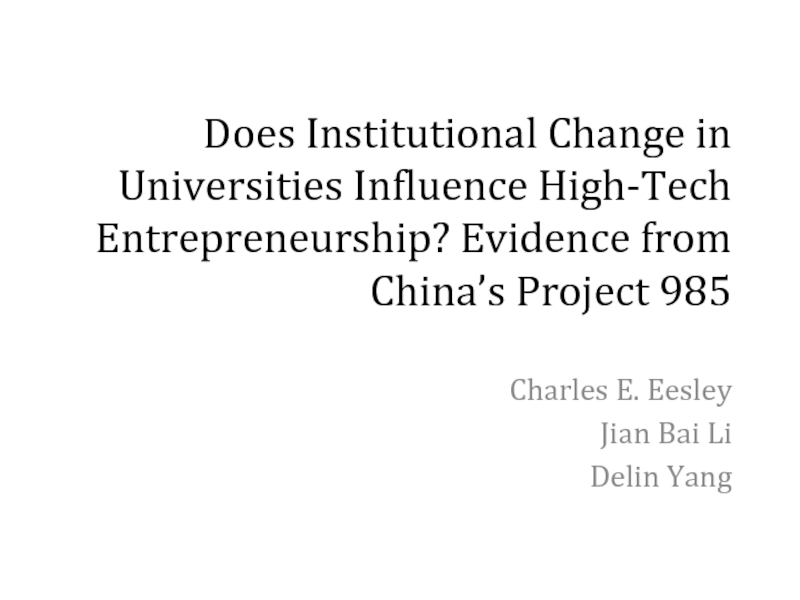
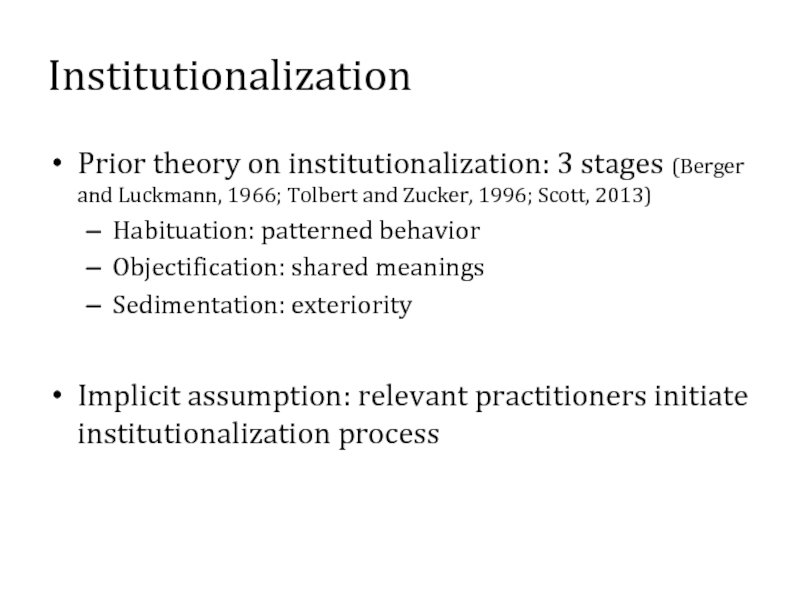
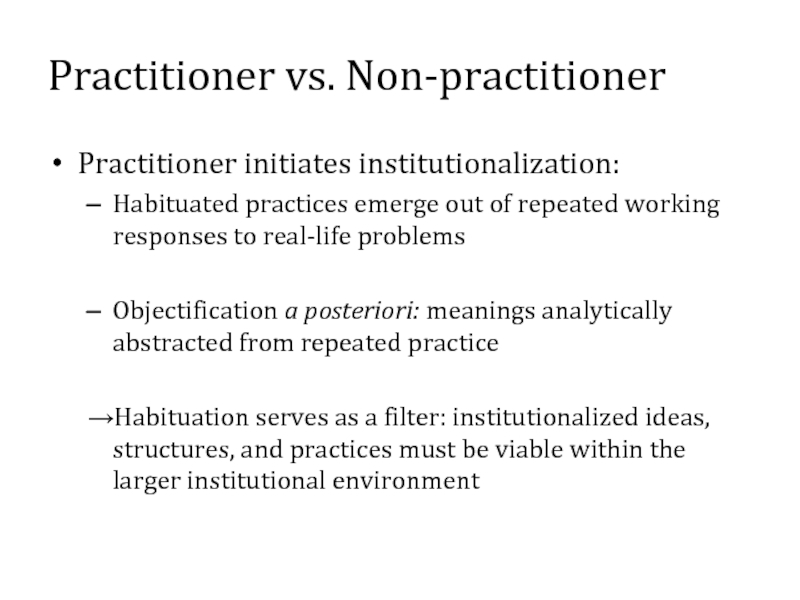
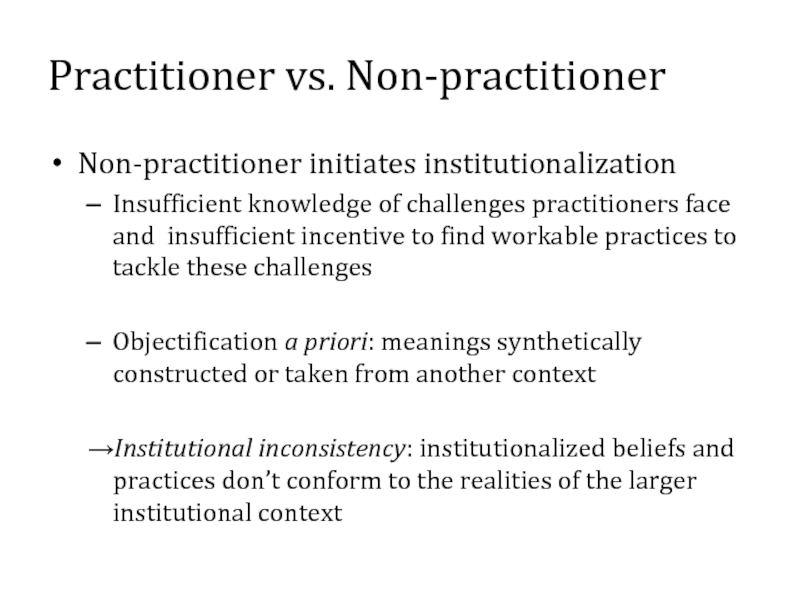
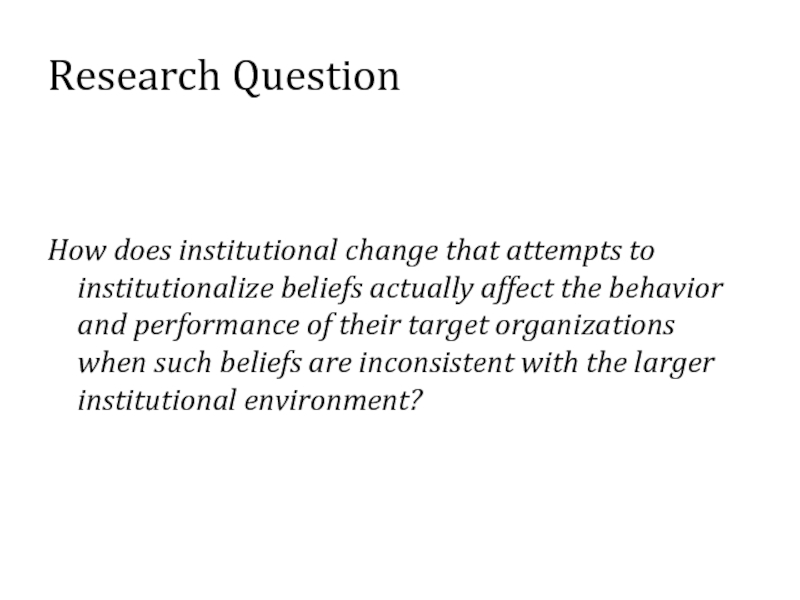
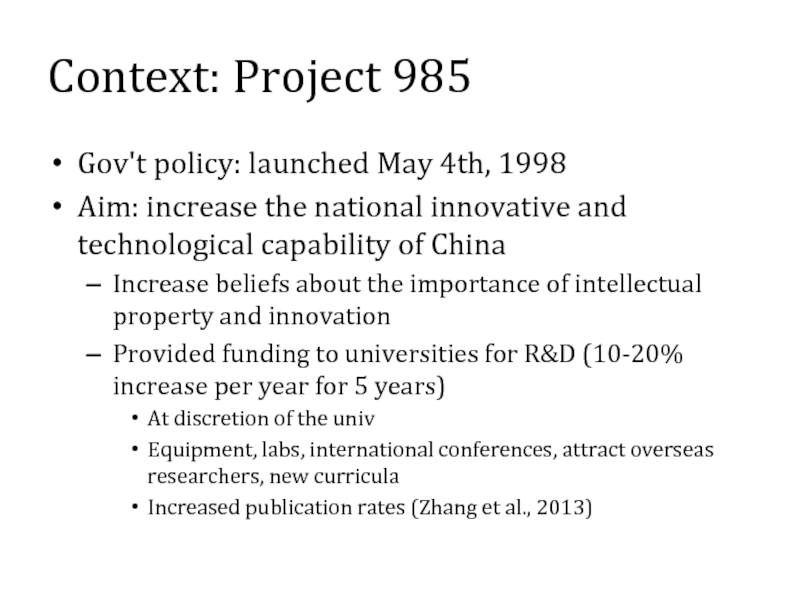
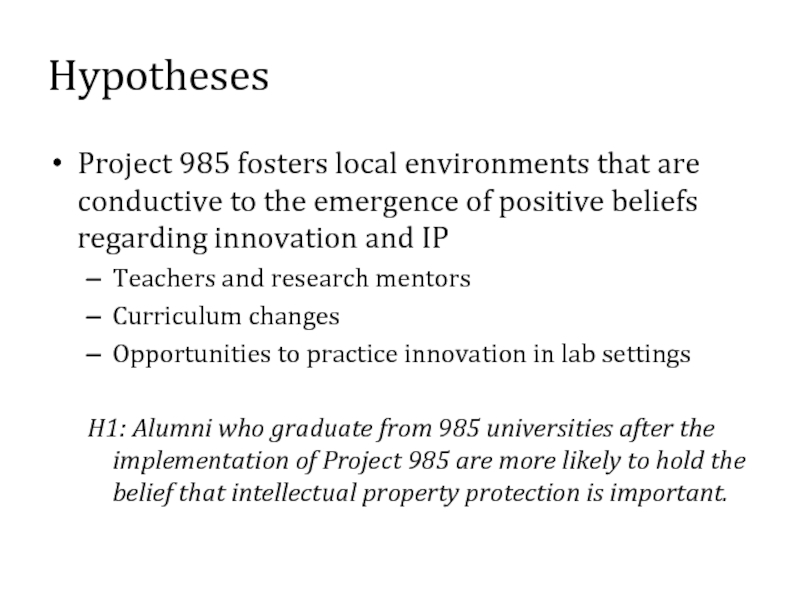
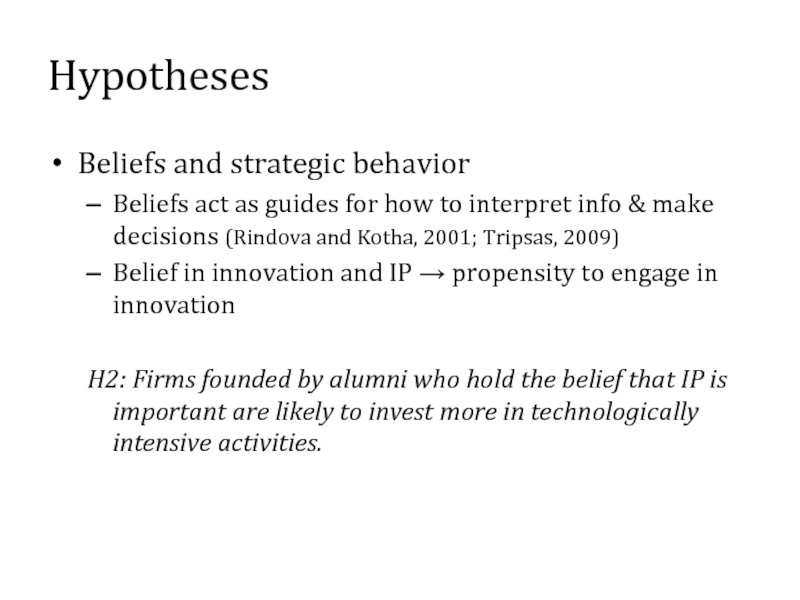
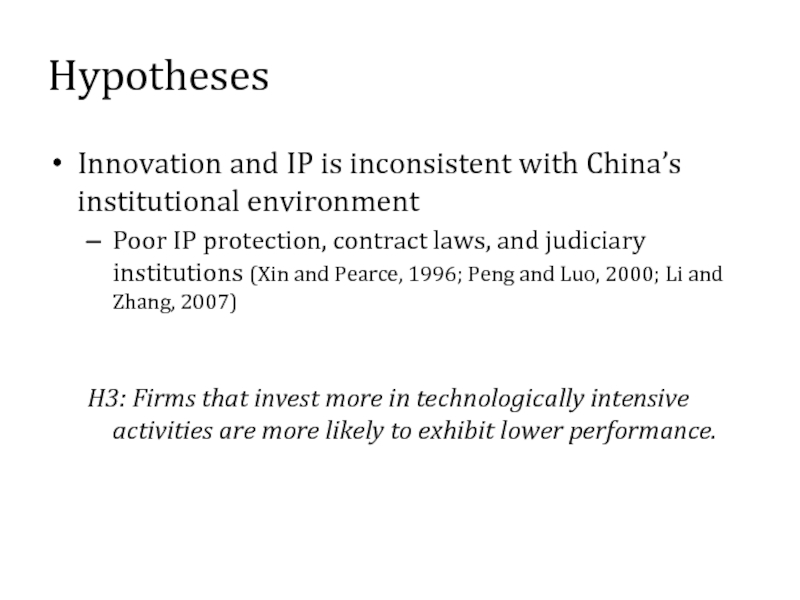
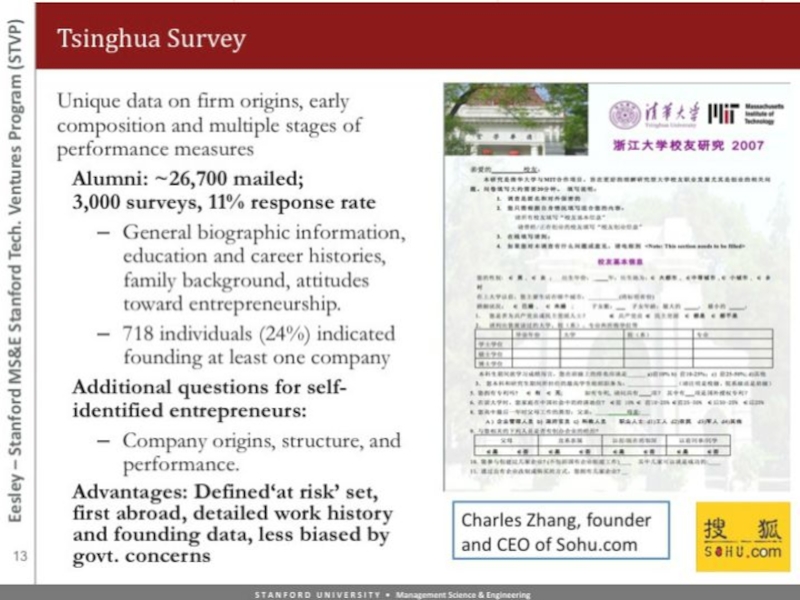

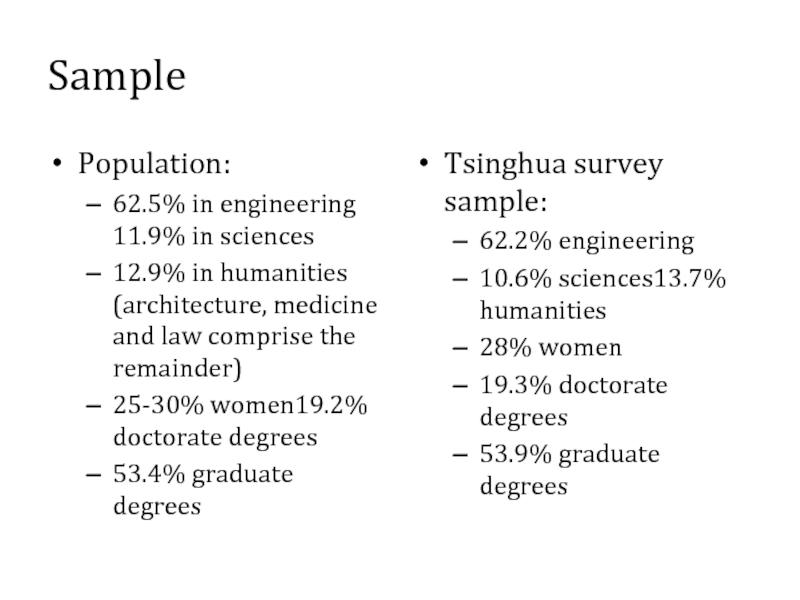
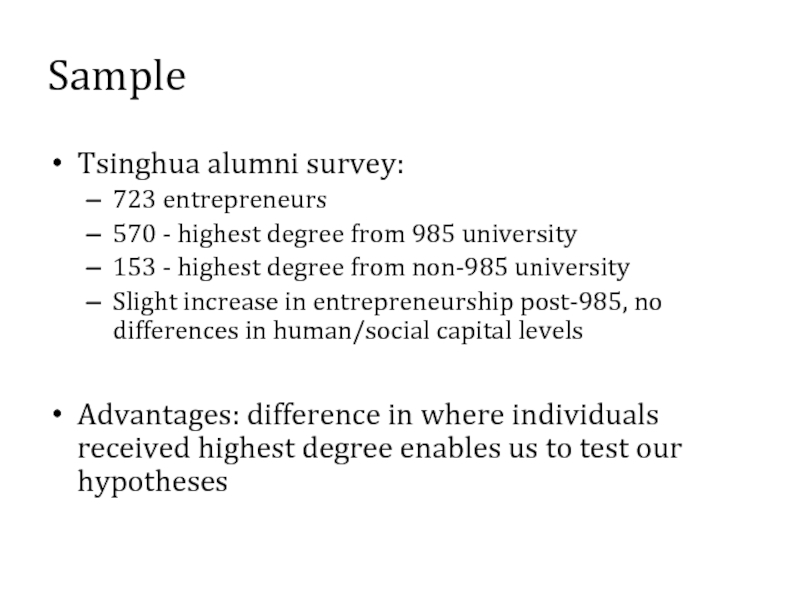

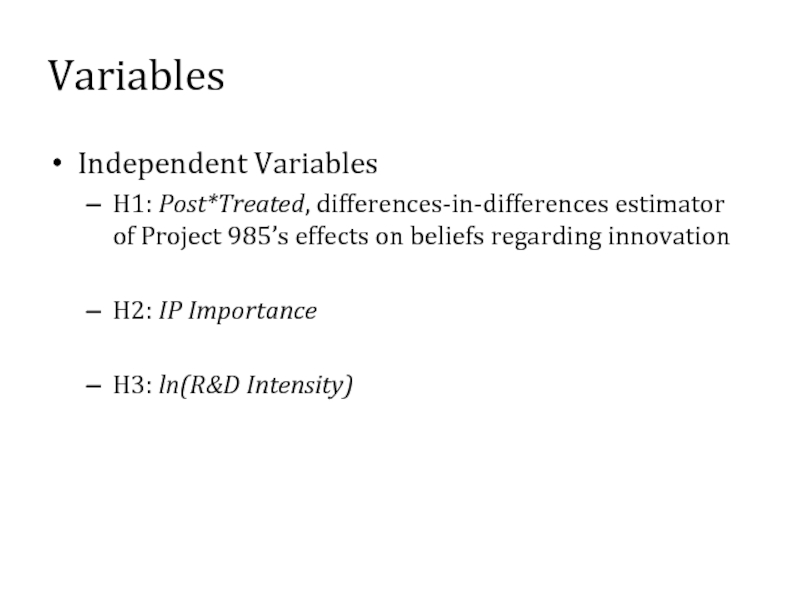
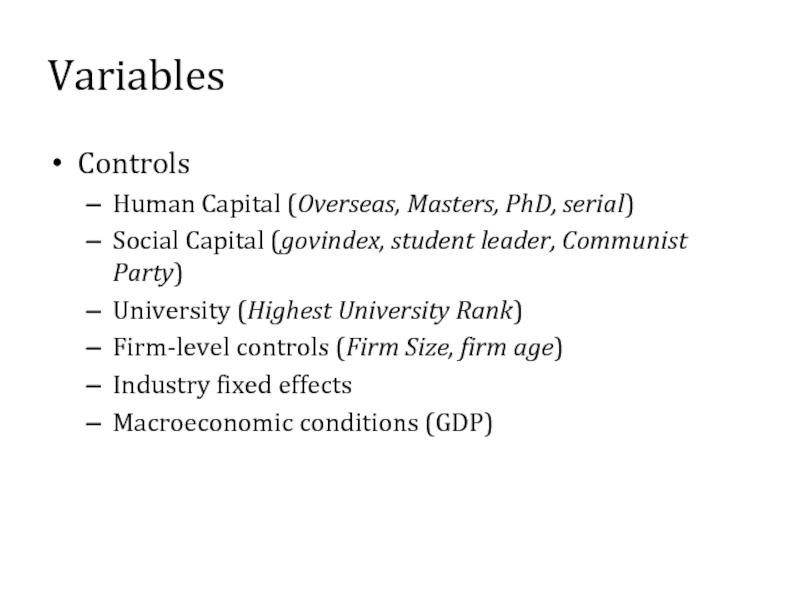

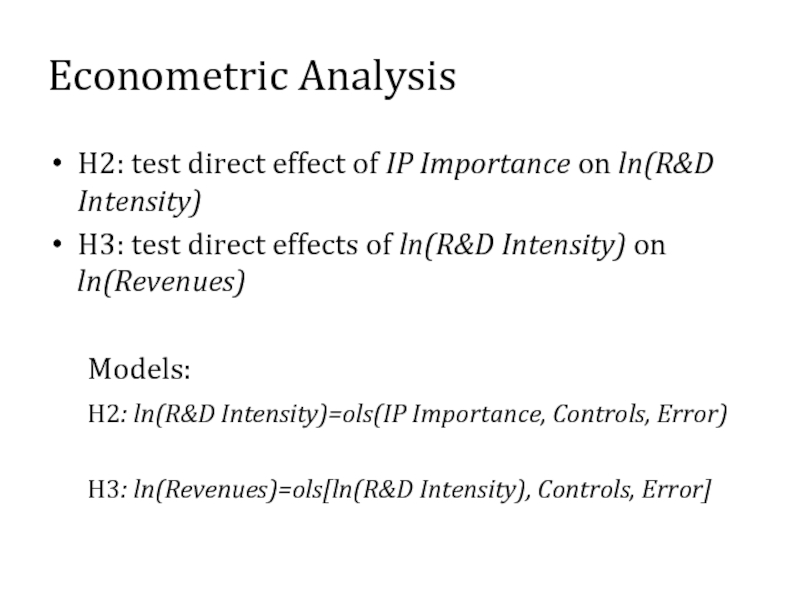
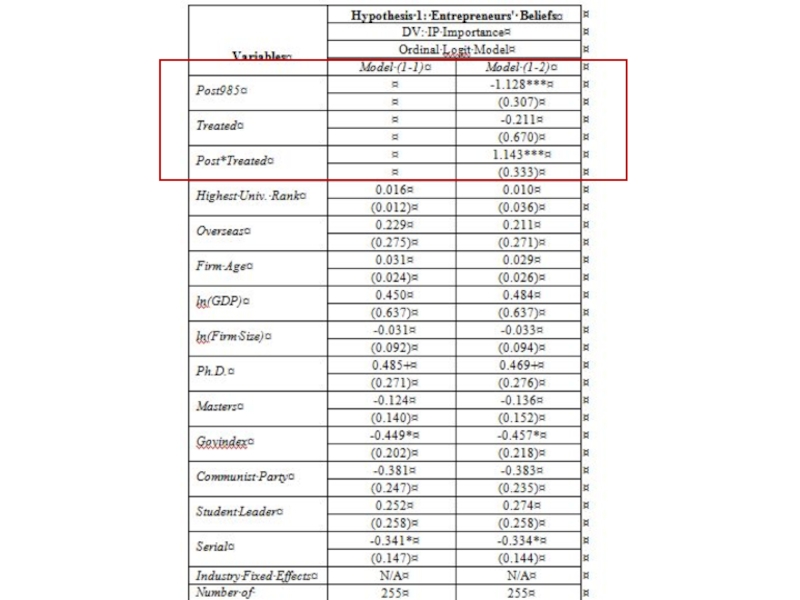
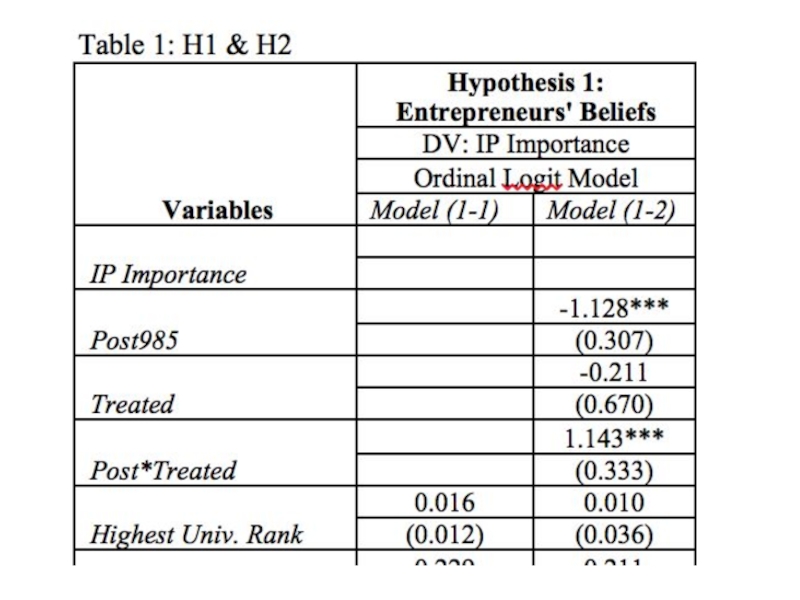
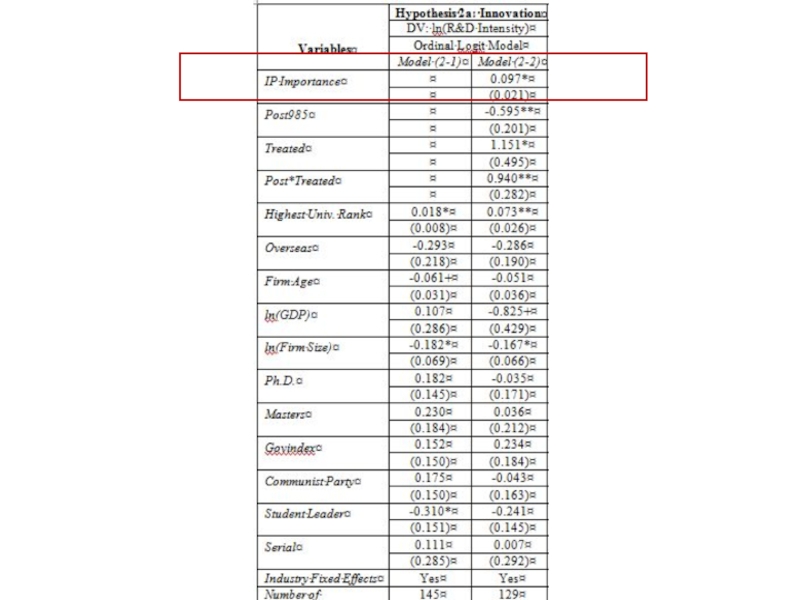
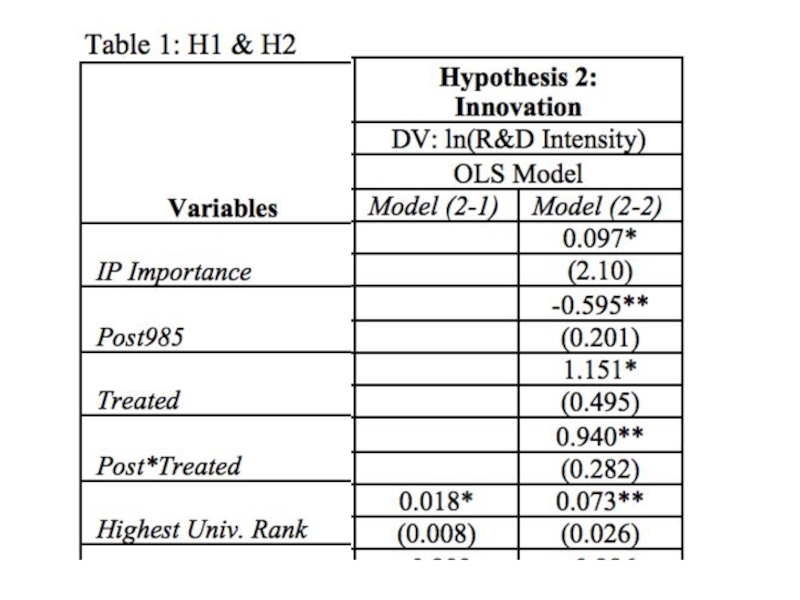

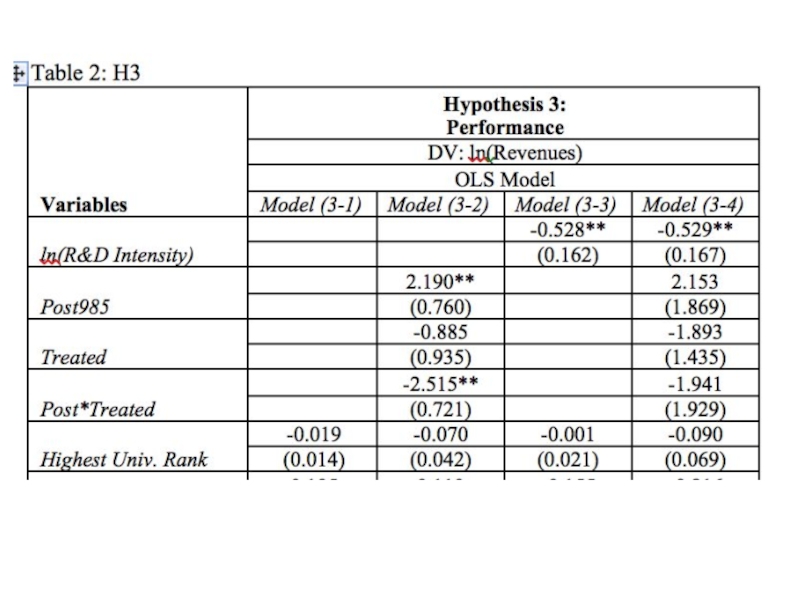
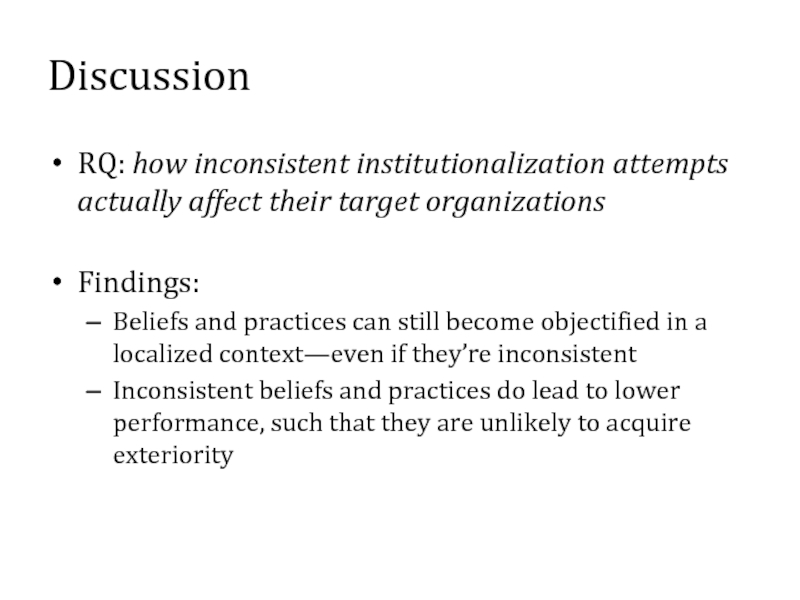

![“I know that a lot of [Chinese] people are hyped about technology entrepreneurship, but I](/img/tmb/3/229753/8d9dd4c32f206b8d9bc820188b72ee7b-800x.jpg)
